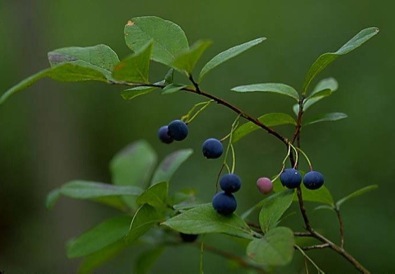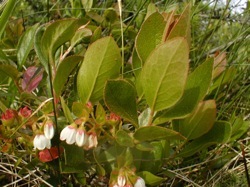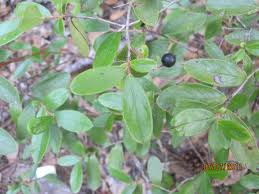Gaylussacia: Huckleberry History
What’s the difference between a blueberry and a huckleberry?
There’s almost an easy answer. The huckleberry looks like a black blueberry, and it has exactly 10 seeds inside. Also, if you have a magnifying lens with you the underside of the huckleberry leaves will have little yellow dots that sparkle. There are also blue huckleberries, but they still have 10 seeds and the leaves still have little yellow oil glands on the bottom of the leaves. The stony seeds make the huckleberries crunchier. If you want to get technical, blueberries are true berries whereas huckleberries are drupes, but they are also an exception to the drupe rule by having 10 seeds not one, like an olive.
Despite all that huckleberries resemble blueberries and they are used like blueberries, though they are often sweeter. Huckleberries, like blueberries, are in the heath family. There’s 50 species or so in the genus and are found in North and South America, most of them in South America.
Growing up in New England, all the huckleberries I saw where about the same size in height as all the blueberries, and looked similar in leaf structure. Here in the South huckleberries can be small trees with large leaves. You have to look for the fruit and the gold spots on the underside of the leaves. That said there some small versions but I’ve rarely seen them. Locally there are the Gaylussacia frondosa, Gaylussacia dumosa, and Gaylussacia mosieri.
Huckleberry are food for deer, birds, rodents, insects, and bears. Huckleberries are one of the grizzly bear’s favorite foods, comprising up to one third of their diet. Bears will travel great distances to find them. If you do go huckleberry picking be aware that you may be in some bear’s favorite patch. In fact I was holding a class one day with about a dozen students and I said we could encounter bear and we did in the huckleberry patch, a good-sized black bear who decided a dozen to one was bad odds.
The species was named for French chemist Louis Joseph Gay-Lussac, 1778-1859. He discovered the law of combining volumes of gasses. The genus is pronounced Gay-lus-SAY-shee-uh. The species dew-MOE-sa (bushy shrubby) fron-DOE-sa (leafy, fernlike) and moe-see-ERR-ee, named for Charles A. Mosier, 1871-1936, first superintendent of Florida’s first state park, the Royal Palm State Park.
The word “huckleberry” came from a mistake, according none the less than Henry David Thoreau. He said it came from hurtleberry which was a corruption of heart-berg, or hart’s berry. Hurtleberry was also Whurtleberry and Whurtles. Some folks still call blueberries/blackberries Whortles, Wurtles, Wurts and Hurts. Even some botanical publications when talking about blueberries (Vacciniums) will call them huckleberries. (To read about blueberries go here.)
Huckleberries where much used by Native Americans. In the Journals of Lewis and Clark, they wrote of Indians using dried berries extensively. On reaching the Shoshone Tribe on 15 August 1805, Lewis wrote:
“This morning I arose very early and as hungry as a wolf. I had eaten nothing yesterday except one scant meal of the flour and berries, except the dried cakes of berries, which did not appear to satisfy my appetite as they appeared to do those of my Indian friends. I found on inquire of McNeal that we had only about two pounds of flour remaining. This I directed him to divide into two equal parts and to cook the one half this morning in a kind of pudding with the berries as he had done yesterday, and reserve the balance for the evening. On this new-fashioned pudding four of us breakfasted, giving a pretty good allowance also to the chief, who declared it the best thing he had tasted for a long time. . .”
The tribes made rakes of salmon backbones to strip huckleberries off the bushes. They dried the berries in the sun or smoked them, mashed them into cakes and wrapped these in leaves or bark for storage.
Green Deane’s “Itemized” Plant Profile
IDENTIFICATION: G. dumosa is a small shrub seldom larger than two feet. G. frondosa grows larger to about five feet, but is sparely covered with leaves. They will have black to blue berries that resemble blueberries. Look for gold dots on the underside of leaves. They are tiny. You will need a lens. All huckleberries have these spots and ten seeds. Flowers are bell shaped. G. frondosa is often tall scraggly, G. dumosa, tiny and hidden. G.mosieri to 3 feet, distinguished by the long glandular hairs on the hypanthium, bracts, pedicels, and twigs: 1-1.5 mm versus less than 0.5 mm for the other species.
TIME OF YEAR: Blooms in late May, fruit in the summer, June to August depending on area.
ENVIRONMENT: In northern areas bogs and wet sandy soils, in southern areas dry or moist sands. Here in Florida they tend to be a tiny bush in saw palmetto prairies and pine flat woods. However, the larger version can be found with more moisture and shade.
METHOD OF PREPARATION: Use like blueberries.
Hucklberry Pie
2 tablespoons flour
¾ cup sugar
3 cups huckleberries, washed carefully
Sift flour and sugar together, add berries and mix well. Pour into pastry-lined pie tin, moisten edge of dough with water, cover with top crust and make openings for steam to escape. Press pastry well over edge and trim. Bake in moderately hot oven for about 45 minutes or until crust is brown. (If cannedberries are used, measure a scant ½ cup sugar.)
USDA Forest Service 1954:40 The Lookout Cookbook







Here in the northwest, there’s lots of Vacciniums, but no Gaylussacias. The blue Vacciniums are “blueberries” and the black or red Vacciniums are “huckleberries”. Red huckleberry is my favorite. Tart and sweet at the same time. 🙂
I’ve found a Huckleberry that goes from red unripe berries to dark blueish ripe berries. I think its G. dumosa but I am not sure. Any help?
Check out the different huckleberry species here:
http://wildhuckleberry.com/species/
Just want to piggy back off Sandy. Her site is a wealth of huckleberry information. You might also want to check out http://www.huckleberrybasket.com
In the East Tennessee mountains, I find both berries growing wild on bushes around a foot tall. Sometimes growing right next to each other. The blueberries taste better to me. The huckleberries seeds get caught in my teeth. The huckleberries tend to be larger but fewer as the blueberries grow in denser clusters. I also pick wild blueberries in middle Tennessee but never found any huckleberries there. The blueberries near mount eagle mountain grow on much taller bushes that the East Tennessee varity but I have found the shorter bushes in several areas of middle Tennessee.
Has anyone made the pie? I can get the 3c. Of berries, but I need to know what kind of flour? All purpose? Any other huckleberry recipes out there anyone likes? I know they can be used in place of blueberries, but I feel like something focused on the huckleberry texture, would be better for me, like they’re pretty crunchy. Anyway, wonderful post 🙂
All purpose flour is fine.
We seem to have an abundance of huckleberries this year here in West Tennessee, or at least in Chester Co. Last year, not so many. Is this a hint of things to come and I should start stockpiling? 🙂
I was wondering if there are any poisonus look a likes to blueberries and huckleberries. There are a lot of websites with long lists of poisonous berries but I’m more concerned with plants that might be VERY similiar. I live on a property loaded with what I believe are wild blueberries. I tasted them and to me taste exactly like blueberries but never actually ate one or swallowed it.
Thanks for any responses.
Not if you look for the “crown.”
Thanks that makes it pretty simple.
Thank You
We’ve been picking “huckleberries” in Western Wash for years, similar looking to blueberries, but a little tart, and bright pink to red in color not blue at all. Are we talking about the same berries?
Don’t think so.